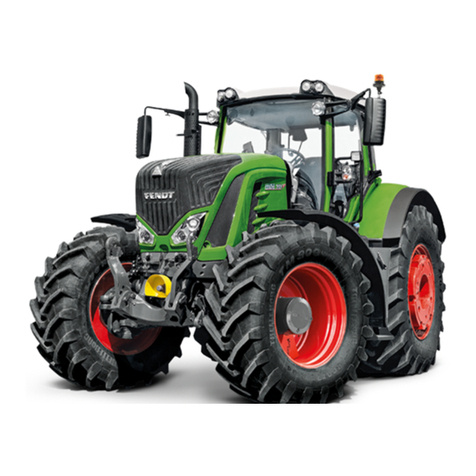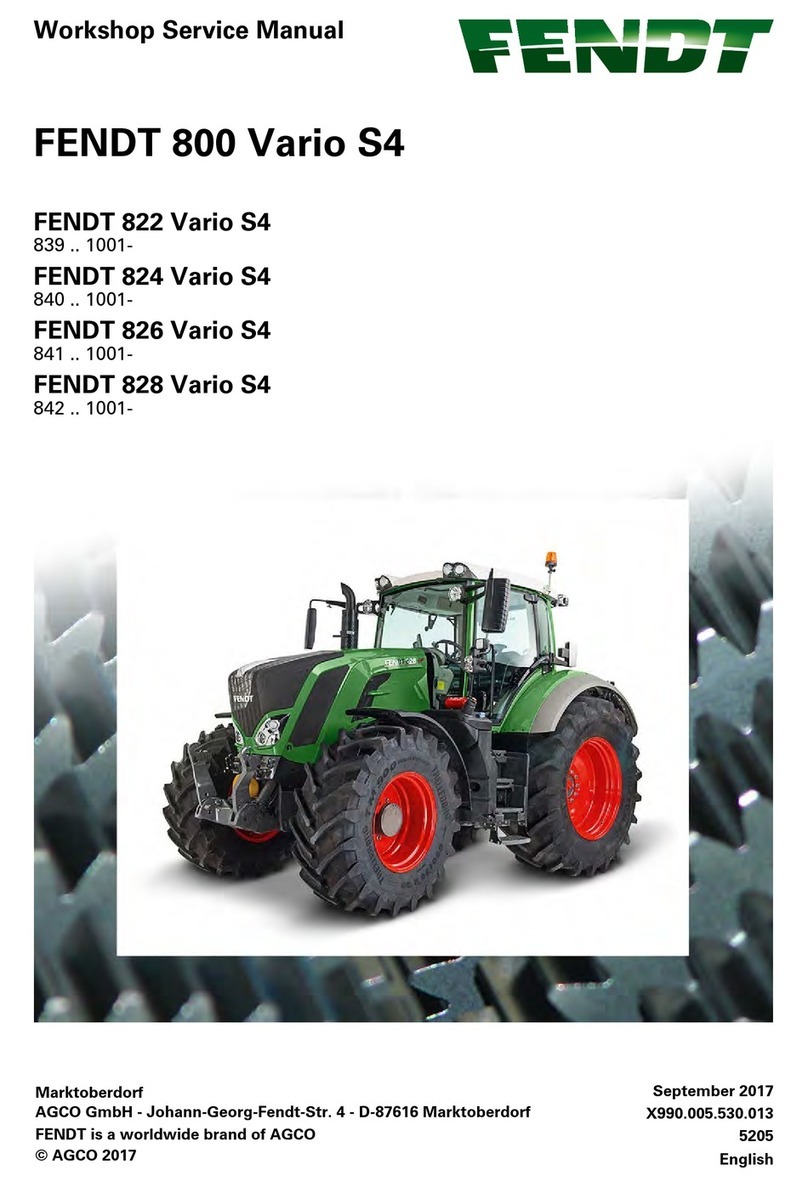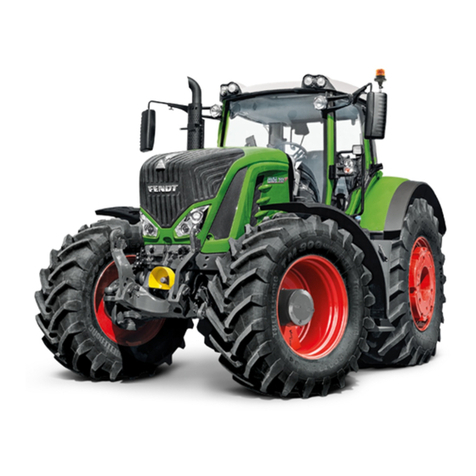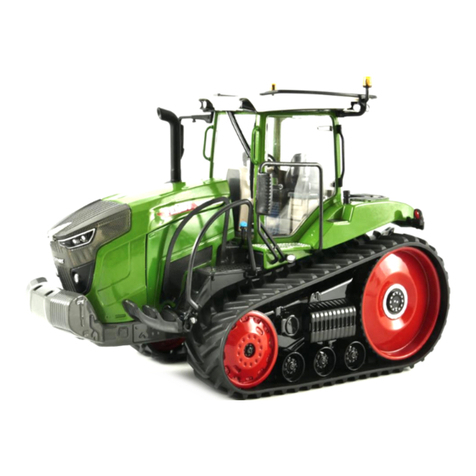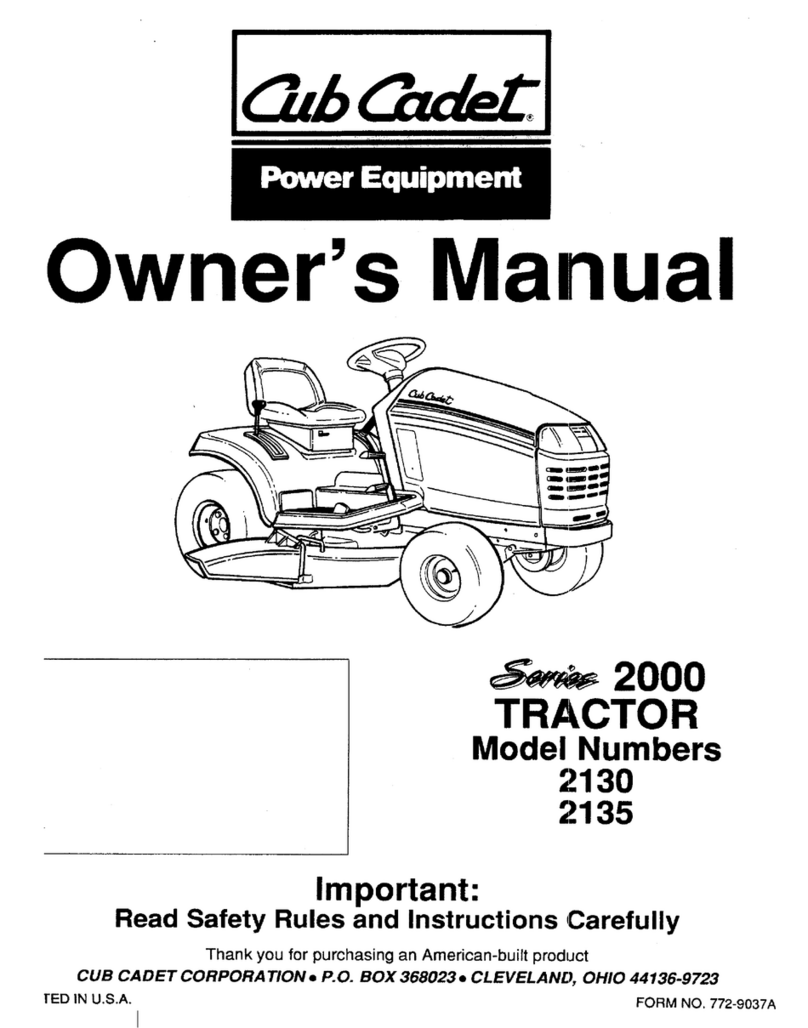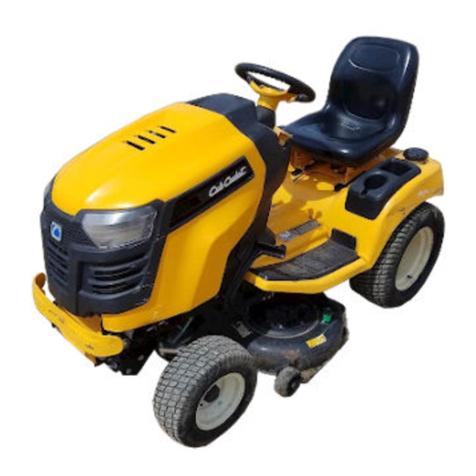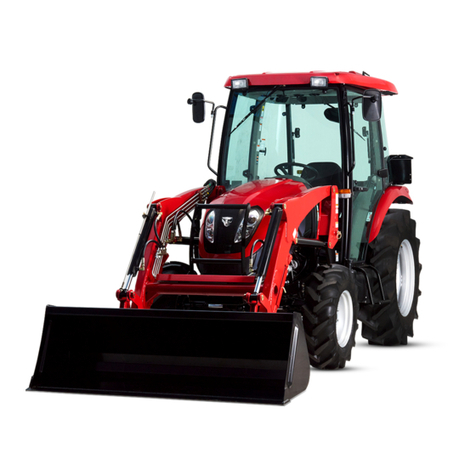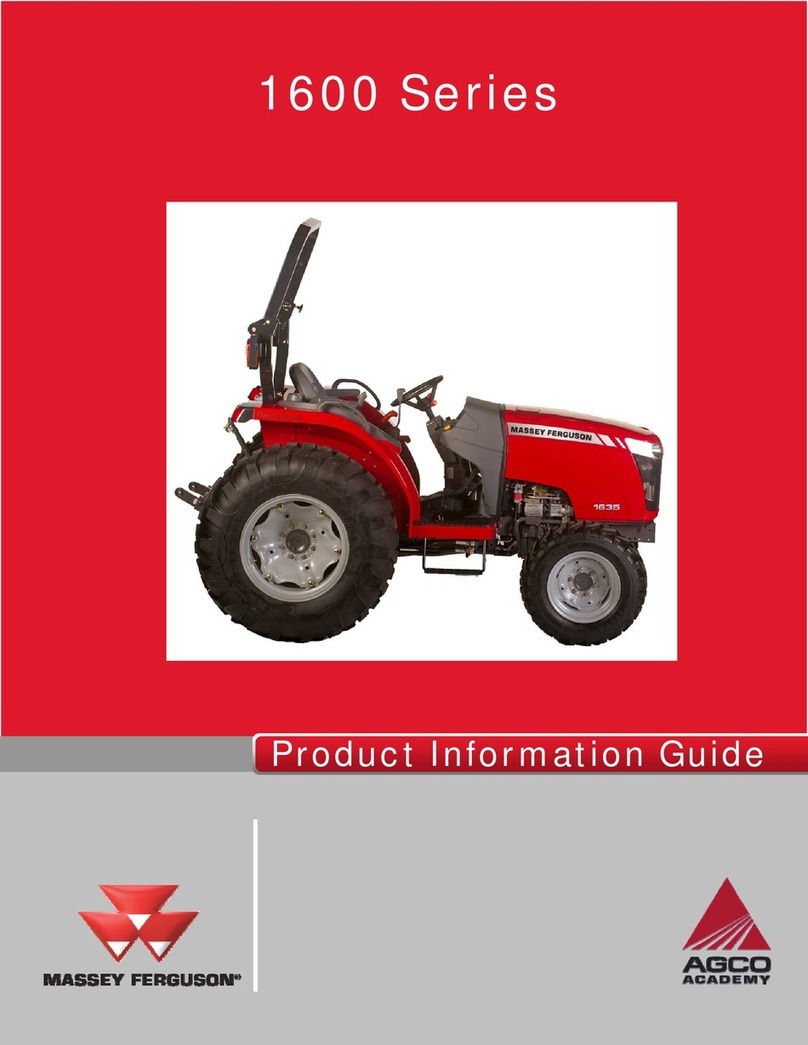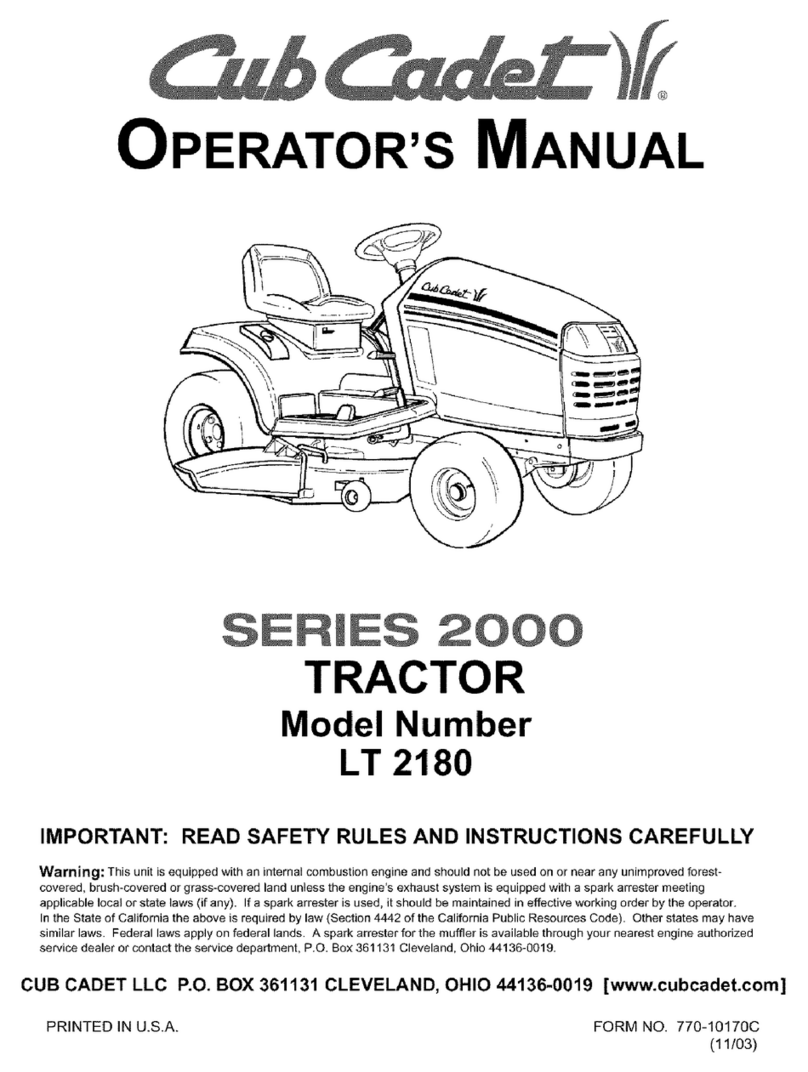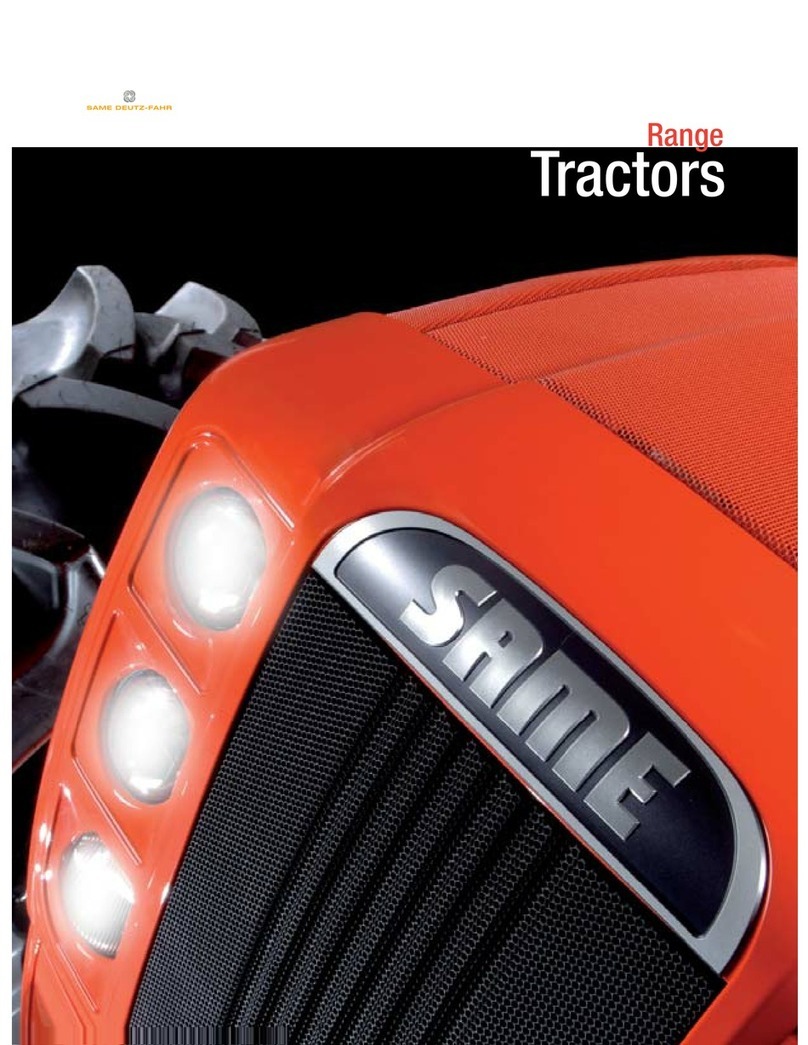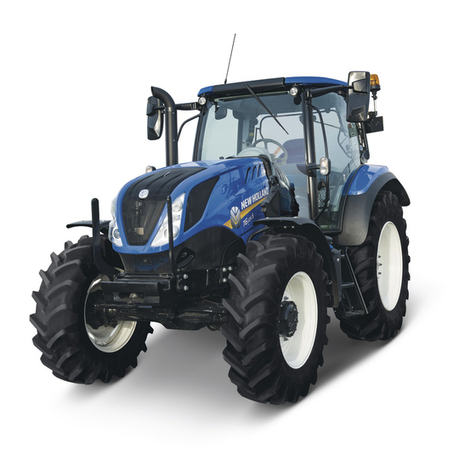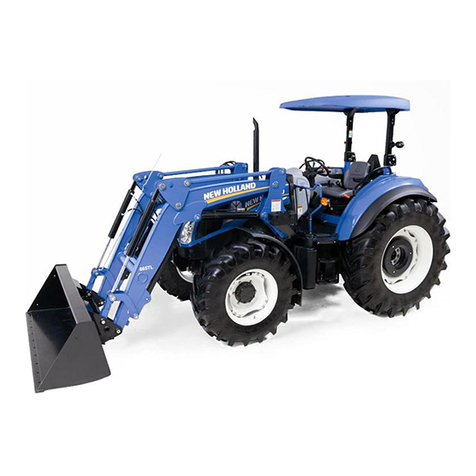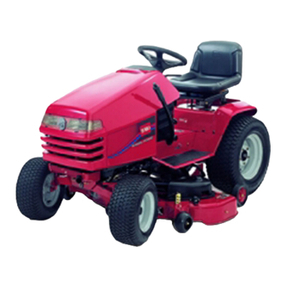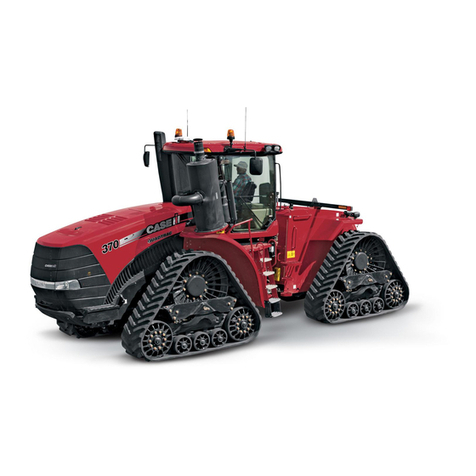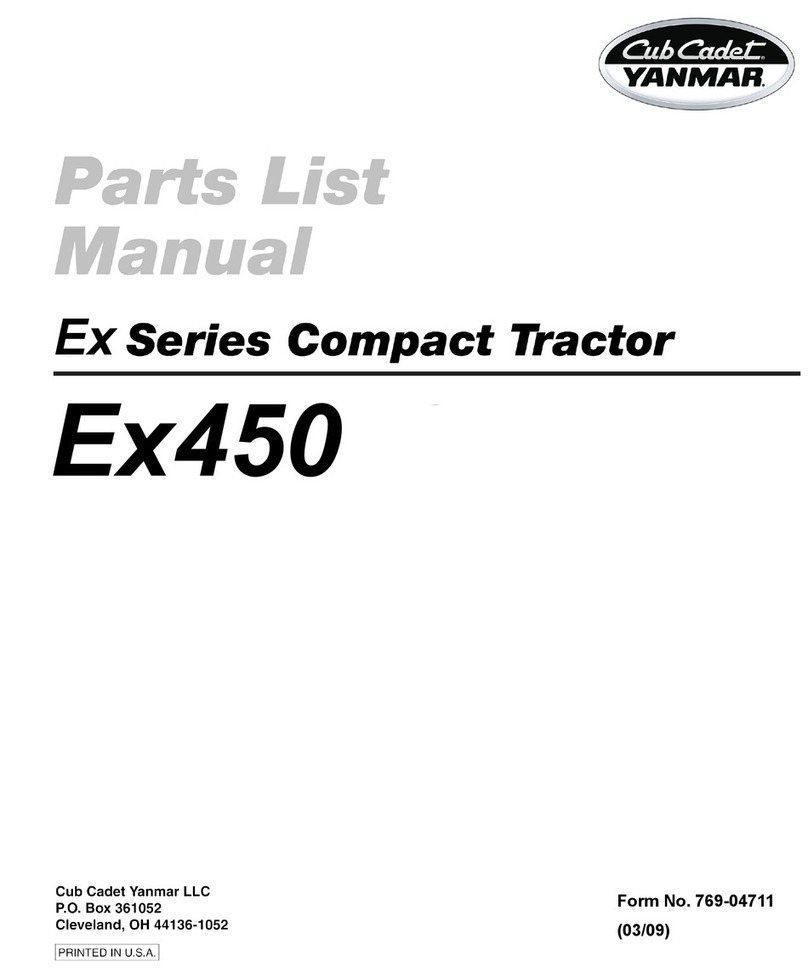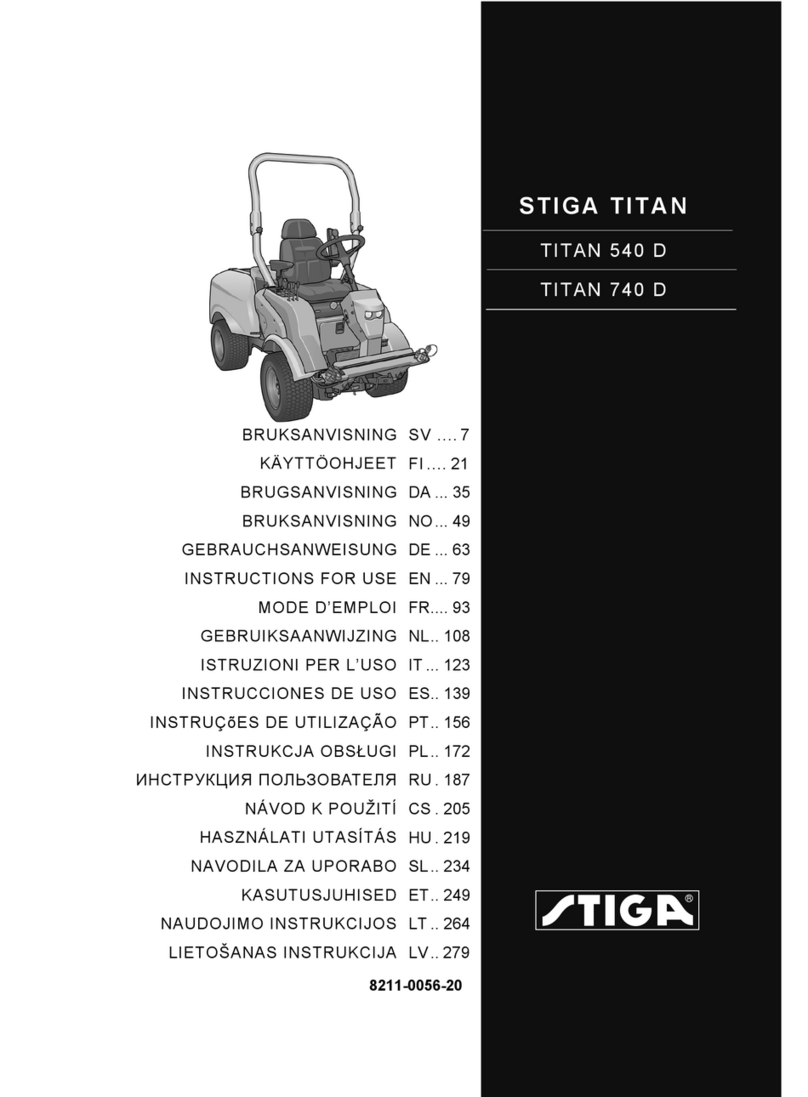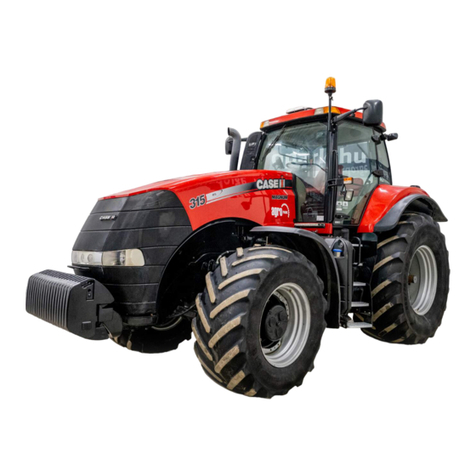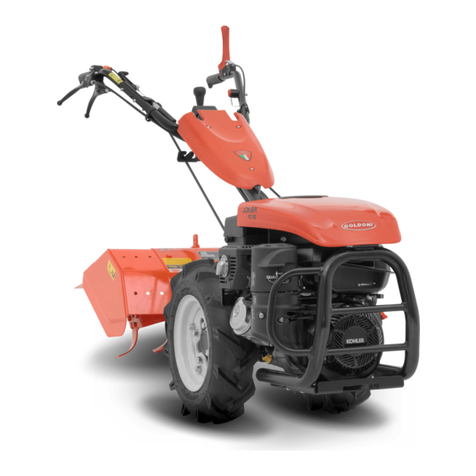FENDT New Leader NL5258G5 User manual

Operator's Manual
New Leader NL5258G5
New Leader NL5300G5
North America
4205 River Green Parkway, Duluth GA 30096 USA
FENDT is a worldwide brand of AGCO
© AGCO 2020
Original Operator's Manual
May 2020
609148D1A
NA
English

CALIFORNIA
Proposition 65 Warning
WARNING: Diesel engine exhaust and some of its constituents are known to the State of
California to cause cancer, birth defects, or other reproductive harm.
WARNING: Battery posts, terminals and related accessories contain lead and lead compounds,
chemicals known to the State of California to cause cancer, birth defects, or other reproductive
harm. Wash hands after handling.
Congratulations on your selection of an AGCO®Product. We believe you
have exercised excellent judgment in the purchase of your AGCO®
machine. We are most appreciative of your patronage.
Your Dealer has performed the pre-delivery service on your new
machine.
He will discuss with you the operating and maintenance instructions
given in this manual, and instruct you in the correct and varied
applications of this machine. Call on him at any time when you have a
question or need equipment related to the use of your machine.
We recommend that you carefully read this entire manual before
operating the machine. Also, time spent in becoming fully acquainted
with its performance features, adjustments, and maintenance schedules
will be repaid in a long and satisfactory life of the product.
This equipment is covered by a written warranty which will be provided
to you by your AGCO®Dealer at time of purchase.
AGCO®reserves the right to make changes or add improvements to its products at any time
without incurring any obligation to make such changes to products manufactured previously. AGCO
®, or its dealers, accept no responsibility for variations which may be evident in the actual
specifications of its products and the statements and descriptions contained in this publication.
Find manuals at https://best-manuals.com

1 Safety .................................................................... 7
1.1 Safety ............................................................... 9
1.1.1 Safety icons ..................................................... 9
1.1.2 Warnings ....................................................... 9
1.1.3 A word to the operator ............................................. 9
1.1.4 Engine safety instructions .......................................... 10
1.1.5 Safe operation .................................................. 11
1.1.5.1 Prepare for operation .................................... 11
1.1.5.2 General information ..................................... 12
1.1.5.3 Emergency situations ................................... 13
1.1.5.4 Personal protective equipment ............................. 13
1.1.5.5 Seat safety ........................................... 13
1.1.5.6 Operator not on the operator's seat ......................... 13
1.1.5.7 Shields and safety guards ................................ 14
1.1.5.8 Exhaust warnings ...................................... 14
1.1.5.9 Ejected material ....................................... 14
1.1.5.10 Handrails ............................................ 15
1.1.5.11 Procedure if the machine touches a high-voltage source .......... 15
1.1.5.12 Start the engine ....................................... 15
1.1.5.13 Drive the machine on the road ............................. 16
1.1.6 Safe maintenance ................................................16
1.1.6.1 Operator maintenance ................................... 16
1.1.6.2 General maintenance information ........................... 16
1.1.6.3 How to prevent fires and fire equipment ...................... 17
1.1.6.4 High pressure leaks ..................................... 17
1.1.6.5 Fuel Safety ........................................... 18
1.1.6.6 Engine maintenance safety ............................... 19
1.1.6.7 Electrical safety ........................................ 20
1.1.6.8 Accumulator safety ..................................... 21
1.1.6.9 Pressurized air .........................................21
1.2 Safety decals ....................................................... 22
1.2.1 Caution ....................................................... 23
1.2.2 Conveyor ...................................................... 23
1.2.3 Hazardous materials .............................................. 23
1.2.4 High pressure .................................................. 24
1.2.5 Moving parts ................................................... 24
1.2.6 Pinch point .................................................... 24
1.2.7 Guard missing .................................................. 25
1.2.8 Flying material .................................................. 25
1.2.9 Spinner ....................................................... 25
1.2.10 Falling hazard ................................................... 25
1.3 Informational decals ................................................ 26
1.3.1 Spread pattern .................................................. 27
1.3.2 Lube ......................................................... 27
1.3.3 Conveyor chain tension ............................................28
2 Introduction .............................................................. 29
2.1 Introduction ........................................................ 31
2.1.1 Intended use ................................................... 31
2.1.2 How to correctly dispose of the waste ................................ 31
2.1.3 Pre-Delivery Inspection checklist ..................................... 31
Table of contents
609148D1A
Find manuals at https://best-manuals.com

2.2 System serial number ............................................... 32
3 Operation ................................................................ 33
3.1 Controller operation .................................................35
3.1.1 View the run screen .............................................. 35
3.1.2 Home/run screen icons ............................................35
3.1.3 Configure the machine ............................................ 36
3.1.4 Change the machine settings ....................................... 40
3.1.5 Material profile management ....................................... 43
3.1.5.1 Manage a material profile ................................ 43
3.1.5.2 Create a new material profile .............................. 44
3.1.6 Component calibration ............................................ 48
3.1.6.1 Calibrate the spinner discs ................................ 48
3.1.6.2 Calibrate the spinner assembly ............................ 48
3.1.6.3 Calibrate the feedgate ................................... 49
3.1.6.4 Calibrate the conveyor ................................... 52
3.1.7 Make a new job ................................................. 55
3.1.8 Set the bin level ................................................. 58
3.1.9 Find the optimal feedgate height ..................................... 59
3.1.10 Set boundary spreading ........................................... 60
3.1.11 View machine diagnostics ..........................................62
3.1.12 Set remote spreading ............................................. 65
3.1.13 View the machine hydraulics ........................................ 65
3.1.14 Bleed the cylinders ...............................................66
3.1.15 Flush the bins .................................................. 67
3.1.16 Put the bins into sequence ......................................... 69
3.1.17 Controller default settings .......................................... 71
3.2 System controls .................................................... 73
3.2.1 Armrest controls ................................................ 73
3.2.2 Control instruments .............................................. 73
3.3 Machine preparation ................................................ 75
3.3.1 Prepare the machine for general operation ..............................75
3.4 Spreader preparation ................................................77
3.4.1 Spread pattern test kit ............................................ 77
3.4.2 Calibrate the spread pattern ........................................ 77
3.4.3 Crush strength and size grade number ................................ 78
3.4.4 How to do a crush test ............................................ 80
3.4.5 How to do a size grade number test .................................. 81
3.4.6 Spread pattern test procedure ...................................... 83
3.4.7 Troubleshoot the spread pattern ..................................... 85
3.4.8 Find the eective swath width ...................................... 88
3.4.9 Do a check of the swath width ...................................... 89
3.5 Apply material ...................................................... 91
3.6 Unload the material ................................................. 92
3.7 Application system removal and installation .......................... 93
3.7.1 Spreader box lifting points ......................................... 93
3.7.2 Remove the MultApplier ........................................... 93
3.7.3 Install the MultApplier ............................................ 96
3.7.4 Remove the spinner system ....................................... 102
3.7.5 Install the spinner system ......................................... 105
4 Maintenance .............................................................113
4.1 Lubrication and maintenance ....................................... 115
4.1.1 Maintenance introduction ......................................... 115
4.1.2 Lubricant filling reminders ......................................... 115
4.1.3 Lubricants and fluids ............................................. 115
Table of contents
609148D1A
Find manuals at https://best-manuals.com

4.1.4 Maintenance schedule ........................................... 117
4.2 Hydraulic system maintenance ...................................... 119
4.2.1 Do a check of the hydraulic oil ...................................... 119
4.2.2 Replace the hydraulic oil .......................................... 119
4.2.3 Replace the oil filter ............................................. 120
4.3 System maintenance ............................................... 122
4.3.1 Do a check of the conveyor gear box oil ............................... 122
4.3.2 Change the conveyor gear box oil ................................... 122
4.3.3 Lubricate the front grease bank ..................................... 123
4.3.4 Lubricate the rear grease bank ..................................... 124
4.3.5 Lubricate the MultApplier idler take-up screws .......................... 124
4.3.6 Do a check of the conveyor chain tension ............................. 126
4.3.7 Lubricate the conveyor chain ....................................... 127
4.3.8 Do a check of the conveyor chain ................................... 128
4.3.9 Clean the bin sensor ............................................. 128
4.3.10 Do a check of the spinner fins ...................................... 129
4.3.11 Do a check of the spinner deflectors ................................. 130
4.3.12 Do a check of the material dividers and hillside flow dividers ................ 130
4.3.13 Do a check of the vanes .......................................... 131
4.3.14 Remove a conveyor belt shield ..................................... 132
4.3.15 Install a conveyor belt shield ....................................... 133
4.4 Adjustments ....................................................... 136
4.4.1 Adjust the conveyor chain tension ................................... 136
4.4.2 Adjust the MultApplier conveyor chain tension .......................... 137
4.4.3 Adjust a conveyor belt shield ....................................... 137
4.4.4 Adjust the V-hood ............................................... 139
4.4.5 Adjust the MultApplier feedgate .................................... 140
4.4.6 Fold up the hillside divider ......................................... 141
4.4.7 Fold down the hillside divider ...................................... 142
5 Troubleshooting ......................................................... 145
5.1 Troubleshooting ....................................................147
5.2 Spreader module LED light alerts ................................... 151
5.3 Hydraulic schematics ............................................... 153
5.3.1 Hydraulic schematics ............................................ 153
5.4 Alarms ............................................................ 157
6 Specifications ........................................................... 163
6.1 Application system specifications ................................... 165
6.1.1 Single bin ..................................................... 165
6.1.2 MultApplier complete ............................................ 167
6.1.3 MultApplier only ................................................ 168
7 Index ................................................................... 169
Table of contents
609148D1A
Find manuals at https://best-manuals.com

1 Safety
1.1 Safety .................................................................. 9
1.1.1 Safety icons ........................................................ 9
1.1.2 Warnings .......................................................... 9
1.1.3 A word to the operator .................................................9
1.1.4 Engine safety instructions ..............................................10
1.1.5 Safe operation ...................................................... 11
1.1.5.1 Prepare for operation ........................................ 11
1.1.5.2 General information .........................................12
1.1.5.3 Emergency situations ....................................... 13
1.1.5.4 Personal protective equipment .................................13
1.1.5.5 Seat safety ............................................... 13
1.1.5.6 Operator not on the operator's seat ............................. 13
1.1.5.7 Shields and safety guards .................................... 14
1.1.5.8 Exhaust warnings .......................................... 14
1.1.5.9 Ejected material ........................................... 14
1.1.5.10 Handrails ................................................ 15
1.1.5.11 Procedure if the machine touches a high-voltage source .............. 15
1.1.5.12 Start the engine ........................................... 15
1.1.5.13 Drive the machine on the road ................................. 16
1.1.6 Safe maintenance ................................................... 16
1.1.6.1 Operator maintenance .......................................16
1.1.6.2 General maintenance information ...............................16
1.1.6.3 How to prevent fires and fire equipment ..........................17
1.1.6.4 High pressure leaks .........................................17
1.1.6.5 Fuel Safety ............................................... 18
1.1.6.6 Engine maintenance safety ................................... 19
1.1.6.7 Electrical safety ........................................... 20
1.1.6.8 Accumulator safety ......................................... 21
1.1.6.9 Pressurized air ............................................ 21
1.2 Safety decals ........................................................... 22
1.2.1 Caution ........................................................... 23
1.2.2 Conveyor ..........................................................23
1.2.3 Hazardous materials ................................................. 23
1.2.4 High pressure ...................................................... 24
1.2.5 Moving parts ....................................................... 24
1.2.6 Pinch point ........................................................ 24
1.2.7 Guard missing ...................................................... 25
1.2.8 Flying material ...................................................... 25
1.2.9 Spinner ........................................................... 25
1.2.10 Falling hazard .......................................................25
1.3 Informational decals .................................................... 26
1.3.1 Spread pattern ......................................................27
1.3.2 Lube ............................................................. 27
1.3.3 Conveyor chain tension ............................................... 28
Table of contents
7
609148D1A
Find manuals at https://best-manuals.com

1.1 Safety
1.1.1 Safety icons
The safety warnings show in the manual with these icons:
DANGER:
This is an immediately dangerous
situation which, if you ignore it, will
cause death or injury.
WARNING:
This is an immediately dangerous
situation which, if you ignore it, can
cause death or injury.
CAUTION:
This is an immediately dangerous
situation which, if you ignore it, can
cause injury.
GUID-8B3A5C56-82B5-4B83-96F1-A9D3FC2345DB-high.jpg [High]
Fig. 1
Secondary information
2 types of secondary information are shown when necessary.
IMPORTANT: This identifies special instructions or procedures which, if not followed can cause damage to
the machine. It might also cause damage to the process, or the area around the machine.
NOTE: Information to help you do the procedure, or help you to understand.
1.1.2 Warnings
You can prevent most accidents when you obey the warnings and the safety instructions. To increase your
safety, and that of others, make sure that:
• Other personnel know that you are on the machine when all maintenance occurs.
• All personnel can see the applicable safety and maintenance instructions.
When compared to your machine, there can be some small dierences with the information in this manual.
1.1.3 A word to the operator
• You must read and understand the safety
section in this operator's manual, and the
manuals for all implements, before you operate
this machine.
• The safety procedures in this manual increases
protection to all personnel in and around the
machine, while it is in operation or during
maintenance.
This safety section:
• Tells you some of the basic hazardous
situations that can occur during the usual
operation and maintenance of the machine.
• Gives you procedures that can help prevent
these hazards.
• Adds to the safety procedures in other sections
of this manual.
GUID-92F4604C-E8C4-419F-A2C4-B952B1137BCB-high.jpg [High]
Fig. 2
[V]
GUID-5CB29D89-93BD-44B9-B034-8882D5B7A392 [V3]
GUID-057548B6-B2DF-4696-A55B-A71DE9806D75 [V1]
GUID-D6DA51A7-C1FB-4F7A-9C54-888FE0B58569 [V2]
1. Safety
9
609148D1A
Find manuals at https://best-manuals.com

Precautions:
•Injury or death can occur if you do not obey these precautions.
• Other precautions can be necessary when you attach implements to the machine.
• Other precautions can be necessary when the conditions change in the work area, or area where you
do the servicing.
• The manufacturer is not liable for the machine:
- If you do not use the machine for its intended use.
- If you do not operate the machine correctly.
- If you do not do the correct inspections of the machine.
- If you do not lubricate the machine correctly.
- If you do not obey the maintenance schedule.
• It is your responsibility to obey the safety procedures when you operate, or do work on the machine.
Before you operate the machine, make sure that you have the approval to use it.
To have the approval to use this machine you must:
• Know how to use it.
• Know the safety instructions.
• Obey the applicable local laws.
There is a minimum age to operate some machines.
It is your responsibility to know these laws and obey them when you operate the machine or if a situation
occurs.
For your safety and the safety of others, obey all safety decals and notices on the machine and on all
implements.
Only use equipment or implements that have the machine manufacturer's approval.
Make sure that your machine has the correct equipment that is necessary by the local laws.
Do not use alcohol or drugs when you do work with the machine. They decrease your control of the
machine.
If you have a medical condition or use medicine, speak to medical personnel to make sure that you are safe
to operate the machine.
1.1.4 Engine safety instructions
• Make sure that all shields, guards and access doors are in the correct position and closed before you
start the engine.
• Make sure that no personnel are near the machine before you start the engine. Operate the horn 2
times before you start the engine to warn personnel.
• Before you start the engine, make sure that:
- All the controls are in the neutral position.
- The drive systems are in the disengaged position.
• If you start the engine in a closed area, make sure that there is sucient airflow.
• Start the engine from the operator seat only.
• Start the engine only with the start switch in the cab.
• If the machine is in gear, the neutral start system makes sure that the engine does not start. If you
override this system, it can cause death or injury.
• Do not connect booster cables to the starter motor terminals.
GUID-537F9C82-FFA9-45E5-92E4-D84B547112BD [V1]
1. Safety
10
609148D1A
Find manuals at https://best-manuals.com

• Do not use starter fluid to start the engine. This can cause:
- Explosions
- Injury to personnel
- Damage to the machine.
• Keep away from the engine while it is in operation. Before you open the engine cover, stop the engine
and remove the ignition key.
• Do not smoke, have an open fire, or a source of ignition near the fuel system or batteries.
• Do not touch the exhaust manifold, turbocharger and the other hot parts of the engine.
• Do not operate the engine at the idle speed when it is not necessary.
• Keep the engine surfaces clean to prevent the risk of fire.
• Do not disconnect fuel pipes and hoses when the engine is ON. Stop the engine and wait 30 seconds
before you disconnect fuel pipes and hoses.
• The engine contains seals made of viton. If viton is exposed to heat above 300 °C (572 °F) hydrofluoric
acid is made. Put on gloves and clean the area with a alkaline fluid to prevent injury.
• Before you do welding on the machine you must disconnect the:
- Battery
- Engine electronic control unit
- Selective Catalyst Reduction (SCR) supply module.
Cleaning instructions
• To prevent damage to the machine, do not
clean these components with high pressure
fluid:
- Electrical equipment
- Fuel system
- Radiator.
• When you clean the engine, remove unwanted
areas of moisture and then operate the engine
to dry the remaining moisture.
GUID-2769EE7D-AD9B-40B1-869E-CC010E4E300E-high.jpg [High]
Fig. 3
1.1.5 Safe operation
1.1.5.1 Prepare for operation
•Read and understand all the instructions in this manual before you operate, or do maintenance on the
machine.
• Make sure that you know the positions and operations of all the controls.
• Make sure that all controls are in the neutral position and that you engage the parking brake before you
start the machine.
• Make sure that no personnel are in the dangerous areas at all times. Stop the machine if it is necessary.
• Know the dimensions of the machine and have sucient available space for its operation.
• If you operate the machine in these conditions, it increases the risk of injury to personnel and damage
to the machine:
- At high speeds
- Around personnel
- Near buildings
- Near other equipment or possible blockages.
• Do not let children in or near the machine.
• Do not let persons who are not approved operate the machine.
• Do not let other personnel in, or on the machine when in operation.
[V]
GUID-714DCABF-2524-4EAD-A6EA-02C6D89E0126 [V1]
1. Safety
11
609148D1A

• Make sure that the machine is in the correct serviceable condition.
•Obey all local laws. Make sure that the machine has the correct equipment in, or on it.
• All equipment has a limit, make sure that you know the:
- Speed limits of the machine
- Distances and limits for the brakes
- Steering sensitivity
- Steering limits
- Machine limits when on a slope
- Load limits.
1.1.5.2 General information
When the machine is in operation:
• Make sure that you set the machine
components to the correct position when you
operate on a slope.
• Do not get out of the machine when it is
moving.
• Know the dimensions of the machine and make
sure that sucient space is available to let the
machine operate.
• Some of the devices on the machine can make
it not stable. Be careful when you engage
these devices and operate the machine.
• If it is necessary, put on sucient weight to
balance the machine.
• Do not do sudden movements of the controls
when the machine is at high speed or
cornering.
• Decrease the ground speed when you:
- Operate the machine on rough ground
- Turn the machine
- Operate the machine on a slope.
• Do not suddenly reverse the wheels to stop.
Do not use the machine in these conditions:
• When the maximum slope of the ground is
more than the maximum slope limit of the
machine.
• If the level system (if fitted) malfunctions.
• Safety devices not installed and attached
correctly.
• If the tire pressures are not correct.
• If the ground is not stable or has sudden
contour changes.
• The tires do not have sucient contact with the
ground.
• Near to the edge of ditches or steep slopes.
Fig. 4
[V]
GUID-5E28E2D0-7D39-478C-BC18-E7CA125E785B [V2]
1. Safety
12
609148D1A

1.1.5.3 Emergency situations
• Stop the engine in all emergency situations.
•Speak to your local emergency aid.
• Use the fire extinguisher, if it is necessary.
Regularly have an inspection by approved
personnel of the fire extinguisher for correct
operation.
GUID-FF34ACC9-D080-4CD5-9528-F426605803FF-high.jpg [High]
Fig. 5
1.1.5.4 Personal protective equipment
For your safety, during some operations with this
machine, you must use Personal Protective
Equipment (PPE). Obey the instructions when you
see these safety decals.
• Obey all local regulations and use Personal
Protective Equipment (PPE).
• Do not put on loose clothing or other items that
can catch in parts that move.
GUID-BAFB4DD4-D188-4F9B-A0DC-5729B133A3BA-high.jpg [High]
Fig. 6
1.1.5.5 Seat safety
• Put on the seat belt before you operate the
machine.
•Always use the operator's seat when the
machine is moving. Do not get out of the seat
when the machine is moving.
• Use the instructor seat only to show new
procedures to new operators, or to find a
problem.
• Do not let children use the instructor seat or be
in the cab.
• Operate the machine at slower speed and on
flat ground when the instructor seat is in use.
• Do not start, stop, or turn quickly when a
person is in the instructor seat.
• Do not let personnel use the instruction seat
when the machine is on the road.
GUID-5BA328EA-7732-4CE8-97B2-6511151E943C-high.jpg [High]
Fig. 7
1.1.5.6 Operator not on the operator's seat
The operator must not get out of the operator's seat when the machine is in operation. If the operator
does exit the seat, the machine stops all operations.
GUID-4969F957-5C2A-44BF-8C64-1BB52B82D98F [V1]
GUID-656507EC-DA05-4DAD-905F-EB63CB69057D [V1]
GUID-55DB7C7A-F872-4FA0-A7C4-34CDA0103004 [V1]
GUID-ABE4B547-6729-4526-9243-D23E4752A09F [V1]
1. Safety
13
609148D1A

1.1.5.7 Shields and safety guards
• Do not open, remove or try to access areas
behind the shields or guards when the engine
is set to ON.
• After you disengage the engine, some parts
continue to move. Wait for the parts to stop
before you open the shields or safety guards.
• Make sure that all shields and safety guards are
in the correct position before you operate the
machine.
• Do not operate the machine if the shields or
safety guards are damaged. Replace damaged
shields and safety guards.
GUID-CEB32148-1F4C-457C-ADF7-595DFC51AC25-high.jpg [High]
Fig. 8
1.1.5.8 Exhaust warnings
• The exhaust components can become hot
when in operation. Wait for the exhaust system
to become cool before you do work on the
components near the exhaust system.
• Put on personal protective equipment to give
protection to your skin when you do work near
the exhaust system.
• Make sure there is sucient airflow when you
do work on the machine in a building. Open
doors and windows in the building when the
engine is set to ON.
• If the exhaust system is damaged, stop the
machine immediately. Do this to prevent injury
to personnel or damage to the machine.
• Only approved personnel are to do work on the
exhaust system, speak to your local dealer if
necessary.
GUID-55072A39-D882-4355-8ABA-05660F3F6EDA-high.jpg [High]
Fig. 9
1.1.5.9 Ejected material
• Material ejects from the machine at high
speed. The ejected materials can include:
- Crop
- Rocks
- Soil
- Wood
- Other crop material.
• The ejected material can cause damage to the
machine or injuries to the personnel near the
machine.
• Use the safety guards and shields to protect
personnel from the ejected material.
• Put on personal protective equipment if it is
necessary.
• Make sure that no personnel are near the
machine when it is in operation.
GUID-1D480E10-339B-427D-9D05-37E84CC7A29A-high.jpg [High]
Fig. 10
GUID-E7945D3B-5C05-4080-97F6-133CF1B49364 [V2]
GUID-6D805969-1E82-4D9F-A26D-ADFE67ED1E79 [V1]
GUID-E2468D18-416D-4AA5-BAA6-DD5515E49AA4 [V1]
1. Safety
14
609148D1A

1.1.5.10 Handrails
• Make sure that you use the handrails at all
times.
• Always keep 3 points of contact when you go
up or down a ladder.
• Be careful when you are high up on the
machine, if you fall it can cause an injury.
GUID-B4BF5956-B0F7-43A5-85C1-706D96BCA02B-high.jpg [High]
Fig. 1
1
1.1.5.11 Procedure if the machine touches a high-voltage source
You must keep the machine away from
overhead power cables.
If the machine and electrical cables touch, do this
procedure:
• Disengage all the drive components.
• Stop the engine.
• Apply the parking brake.
• Make sure that you can exit the operator seat
safely and do not touch the electrical cables.
• Jump from the last step, make sure that there
is no contact between your body, ground and
machine.
• Do not touch the machine until the electrical
power is set to OFF.
• Tell personnel not to touch the machine.
• Tell the applicable local authorities to disengage
the power.
GUID-DB0A93E4-AEB5-49D5-AC5F-DD1454F1CFC6-high.jpg [High]
Fig. 12
1.1.5.12 Start the engine
Move all hydraulic controls to the hold position before you start the engine.
Make sure the machine is in park.
Press the clutch pedal before you turn the ignition key. The starter will not operate until the clutch has been
pressed. To stop the starter, turn the key to o or release the clutch pedal.
Diesel engine exhaust contains material of combustion which can be dangerous. Always operate the
engine in an open area. If in a closed in area, send the exhaust out.
WARNING:
If you turn the steering wheel with the transmission in the neutral position and the engine
at idle speed, the machine will turn.
WARNING:
Do not use ether. Ether will cause engine damage and/or personal injury.
Do not start the engine until the area is free of personnel to prevent personal injury because of unexpected
machine movement.
GUID-EC20C12A-E05F-4CE0-9228-2B8D7428C65C [V1]
GUID-37F2AAFC-7DFC-42FC-82F8-48D9CD0435FE [V1]
GUID-2E3C7B6F-A752-44EE-B844-B55CE068E322 [V2]
1. Safety
15
609148D1A

1.1.5.13 Drive the machine on the road
•Before you drive, make sure that you know the road specifications of the machine for the:
- Speed
- Brakes
- Steering
- Weight.
• Do not engage the neutral position when the machine goes down a slope.
• Obey local laws and the machine specifications with the speed limit.
• Know and obey all local laws that refer to this machine on the road.
• Make sure that you set all the applicable lamps to ON when you drive the machine. Refer to local laws if
it is necessary.
• Make sure that all the lamps and reflectors are in the correct operation. Repair, clean or replace if it is
necessary.
• Select transport mode on the controls.
• Make sure that the machine's dimensions are not more than the road limits for weight, height, length
and width.
• Look for electrical cables over the road. Change the direction of the machine so that it does not touch
electrical cables.
1.1.6 Safe maintenance
1.1.6.1 Operator maintenance
The operator can only do the machine servicing in these situations:
• They know how to do the work.
• They have all the necessary equipment to do the work.
AGCO recommend you only use AGCO parts and fluids to do servicing and maintenance on your machine.
1.1.6.2 General maintenance information
Before you do the maintenance or repairs:
• Park the machine on a solid level surface.
• Apply the parking brake.
• Put all controls in the neutral position.
• Stop the engine.
• Remove the ignition key from the machine.
• Use the wheel chocks to hold the machine.
• Hydraulic components that lift can fall when the
hydraulic pressure decreases. Make sure that
you use the applicable supports to prevent
component movement.
GUID-DB4C2E27-9DAC-4734-83E4-BC4BB5C26EAF-high.jpg [High]
Fig. 13
When you do the maintenance or repairs:
• Examine the machine for damage or more than usual wear.
• Know that some components can possibly move and hit personnel.
• Only use applicable lift and support equipment that has the correct approval and is specified for the
weight.
• Do not stay below the machine or components when lifted above you.
• Know the dimensions and weight of applicable components when you do the work on the machine.
• Make sure that electrical or hydraulic connections are clean before you disconnect or connect them.
GUID-D8FDC0CD-25E3-4B18-924F-D897E910929E [V2]
[V]
GUID-C30C0C73-EDBC-4ABC-A133-ED5D17C6A39C [V1]
GUID-A8283632-AAD9-4BAC-8C30-72F3911EFB40 [V2]
1. Safety
16
609148D1A

• Only use applicable containers to collect the fluids, for example engine oil.
• Clean all items that spill immediately and correctly discard the unwanted materials.
• Remove all unwanted material from the work area immediately.
1.1.6.3 How to prevent fires and fire equipment
• The crop material is flammable. Regularly
remove the unwanted crop material from the
machine to prevent a fire.
• Use a water type fire extinguisher, A class fire
extinguisher or other water source to
extinguish a crop fire.
• Examine the components to make sure that
they do not become too hot. Listen for noises
that are not usual during operation. Unusual
noises can show that a component has wear.
Worn components can become hot and start a
fire.
• Keep the fire extinguishers in a location that
you can access easily also near where the fires
can occur.
- Examine the fire extinguishers regularly,
refer to the manufacturer's equipment
manual.
- Make sure that the fire extinguisher is full
and in a condition that operates.
• For fires of material other than crop (for
example oil or electrical components), use a dry
chemical fire extinguisher of A, B or C class.
• Before you cut, weld, or grind on the machine,
remove flammable materials from the machine
and the work area.
• If a fire occurs, move out of the smoke and
away from the fire. Get aid from your local
emergency services.
GUID-8FDCA67C-244A-40BA-967B-3FA4E7667A7E-high.jpg [High]
Fig. 14
1.1.6.4 High pressure leaks
• The fluid that leaks from the hydraulic system
or the fuel injection system is at a high
pressure and is not easy to see.
• If the fluid goes into the skin, you must get
medical aid immediately. If the fluid is not
removed immediately, injury or death can occur.
• Use the applicable procedures to find possible
leaks.
- Do not use your bare hand.
- Put on the correct personal protective
equipment before you look for leaks.
• Before you replace hydraulic lines:
- Remove all pressure from the system.
- Put all equipment in the maintenance
position and install the supports if it is
applicable.
- Close the applicable accumulator valves.
- Stop the engine.
GUID-CB450E2E-50DF-4D16-9E59-21C0B3E5B026-high.jpg [High]
Fig. 15
GUID-8B9D8656-A8AB-4AE5-AD08-9140D90556E1 [V1]
GUID-79804E84-5AE4-43FC-871E-0632EEF914F7 [V1]
1. Safety
17
609148D1A

1.1.6.5 Fuel Safety
• Fuel is flammable.
•Always stop the engine before you put fuel in
the machine.
• Keep open flames and electrical sparks away
from the area.
• Do not smoke while you add the fuel.
• Clean the area and remove spilled fuel.
• Only use fuel from an approved fuel container.
• Make sure that a class B fire extinguisher is
available when you fill the machine with fuel.
GUID-C7F758F4-CC0C-482B-9ED5-26557B3F0262-high.jpg [High]
Fig. 16
Ultra-Low Sulfur Diesel
Sparks can cause a fire more easily with Ultra-Low
Sulfur Diesel (ULSD) than with other diesel types.
Equipment (for example hoses) you can use to
decrease the static ignition risk decrease in eect
with time and other conditions.
Ground the machine and bond the fuel equipment
correctly to decrease the risk of static ignition and
a fire. See the equipment manuals for the fuel
equipment for more information.
GUID-E707838B-F5D5-48F0-BF75-34B264F6453D-high.jpg [High]
Fig. 17
GUID-C83E73C4-4979-4F45-AEE0-E3635D592CB7 [V1]
GUID-5BBEAEAD-4451-484C-A34E-3F151A7F385D [V1]
1. Safety
18
609148D1A

1.1.6.6 Engine maintenance safety
• Stop the engine before you do the maintenance
or repair work.
• Before you do the maintenance or repair work
on the electrical system set the battery primary
switch to OFF.
• Surfaces and components near and on the
engine are hot when the engine has operated.
• Always let the components that contain hot
fluid or gas decrease in temperature before you
touch or open them.
• Before you do work on the cooling system,
make sure that you:
- Read the manual for the correct procedure.
- Let the radiator become cool.
- Gradually open the radiator cap to release
the pressure in the system.
• Fuel, lubricants or coolant can cause injury to
your skin. Put on your personal protective
equipment if it is necessary.
• Discard all unwanted materials correctly. Make
sure that you obey all local laws when you
recycle or discard these items.
• It is necessary to replace some components
after you remove them, for example an O-ring.
Make sure that you always replace these
components and do not install them again.
• Only use the components and fluids that have
AGCO approval.
• After you do the maintenance, examine the
work to make sure that it is correct. For
example, do an inspection for leaks.
GUID-81A39ABC-001C-4617-A089-FC6F702EF934-high.jpg [High]
Fig. 18
GUID-8B2A9682-3A5D-4B82-9ADB-71E97A29CE38 [V1]
1. Safety
19
609148D1A

1.1.6.7 Electrical safety
• Before you disconnect the battery, set the
ignition to OFF, wait 2 minutes then disconnect
the battery.
• Make sure that you put on the correct personal
protective equipment when you do work or
maintenance on batteries.
• Lead acid batteries release hydrogen fumes
when charging. The fumes from the batteries
are very flammable. Keep open flames and
electrical sparks away from the batteries.
Charge the batteries in an area with good
airflow.
• Metal tools or objects cause a short circuit the
battery if they touch the positive and negative
connections at the same time.
• If you connect booster cables or charging
equipment incorrectly, it causes damage to the
battery and electrical components. Always
connect the positive cable to the positive
battery connector, and the negative cable to the
negative battery connection.
• The battery contains lead and acid. Put on
personal protective clothing when you do work
on a battery.
• If battery fluid touches your skin, flush the area
immediately with large quantities of water.
• If battery fluid goes in your eyes, flush with
water for a minimum of 15 minutes and get
medical aid immediately.
• If you swallow battery fluid, drink large
quantities of water. Do not try to vomit. Get
medical aid immediately.
• Do not connect 24 V equipment to the
machine.
• If you tilt or turn a battery fluid spills. Keep the
battery with the connections up.
• Always connect the cable to the negative side
of the battery first.
• Always disconnect the cable from the negative
side of the battery first.
GUID-66E185BB-A313-4910-A561-0A73C9B85BFE-high.jpg [High]
Fig. 19
GUID-583CEC9B-0512-48BE-95C6-47CEAA8EAE5D [V2]
1. Safety
20
609148D1A
This manual suits for next models
1
Table of contents
Other FENDT Tractor manuals

FENDT
FENDT FAVORIT 900 Instruction manual

FENDT
FENDT Vario 900 Series User manual

FENDT
FENDT 500 Vario S4 User manual
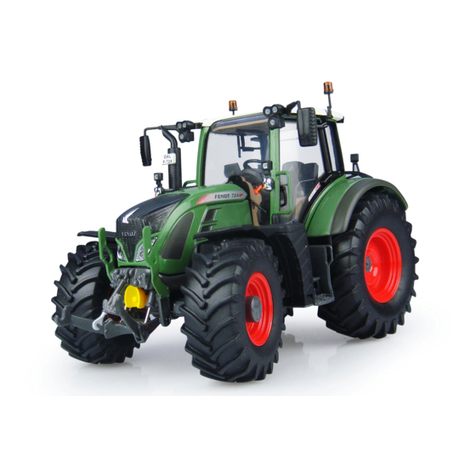
FENDT
FENDT Vario 712 User manual

FENDT
FENDT 916 Vario User manual
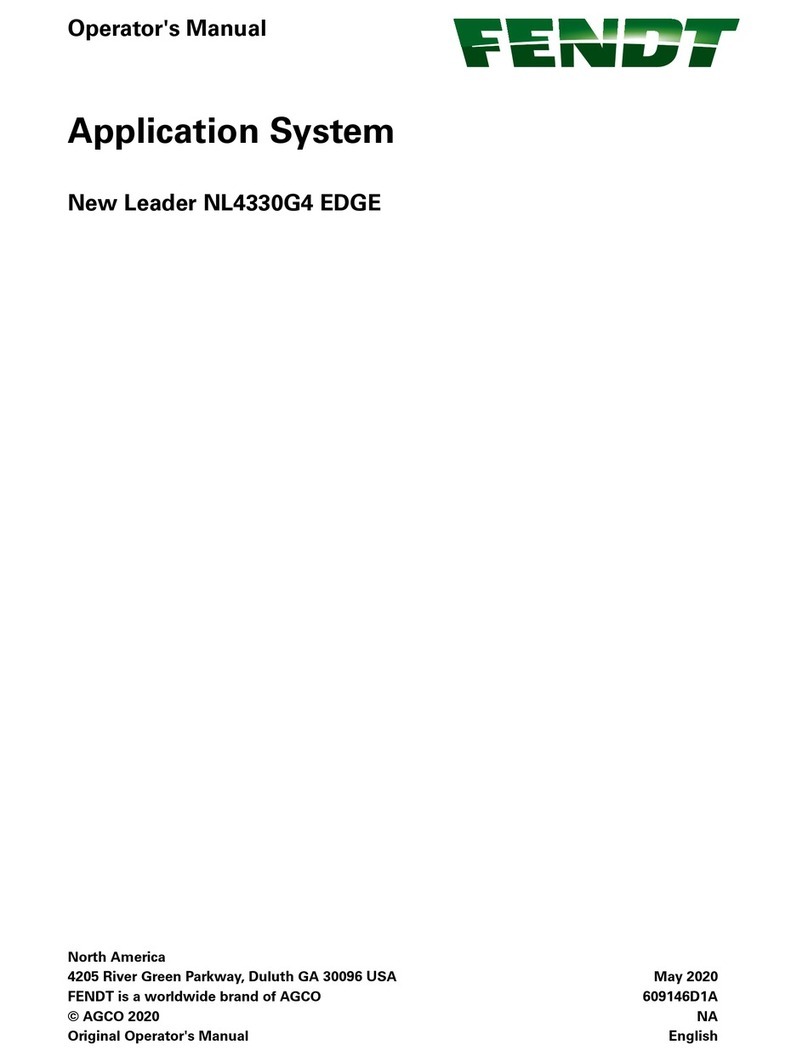
FENDT
FENDT New Leader NL4330G4 User manual
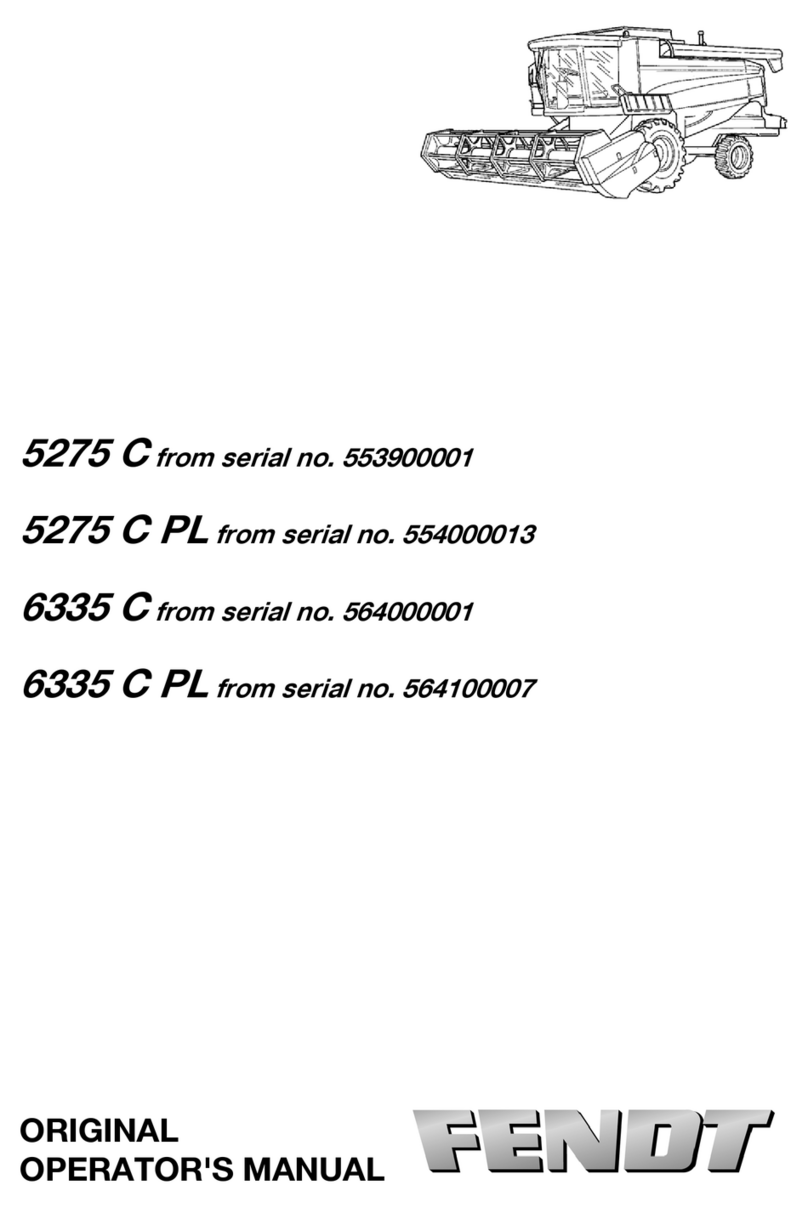
FENDT
FENDT 5275 C User manual

FENDT
FENDT 900 Vario Gen6 Series User manual
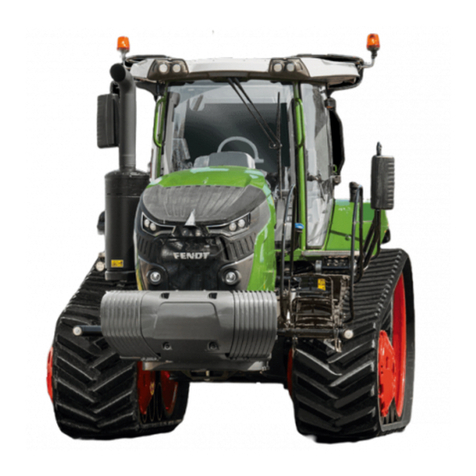
FENDT
FENDT Vario MT 938 User manual

FENDT
FENDT 1149MT User manual


